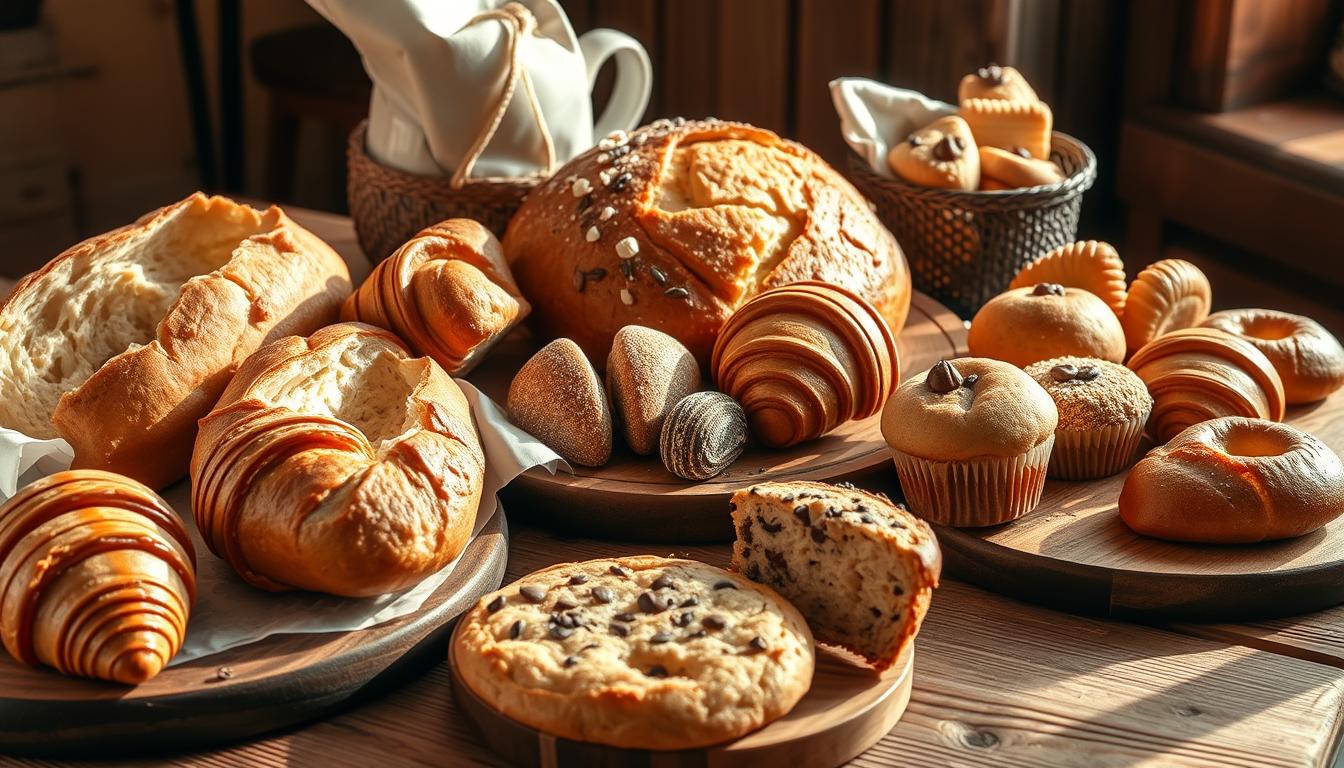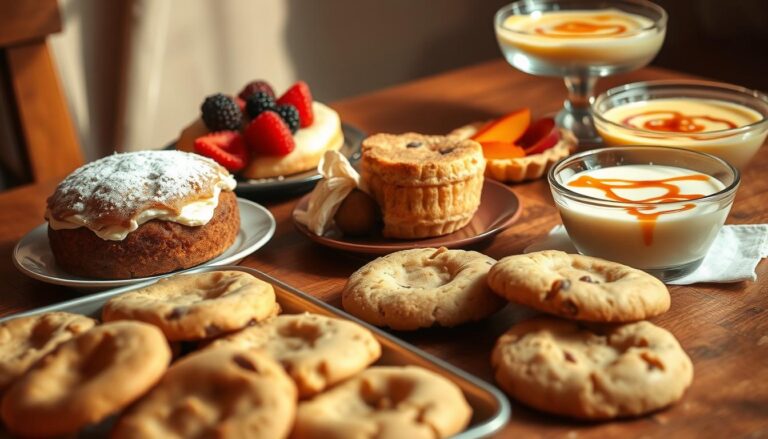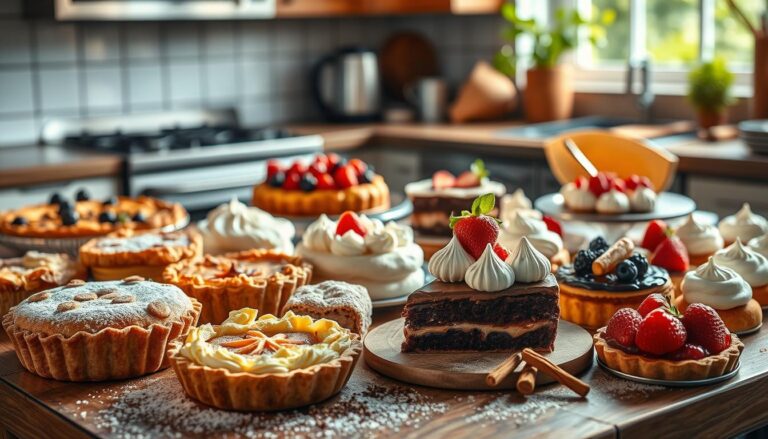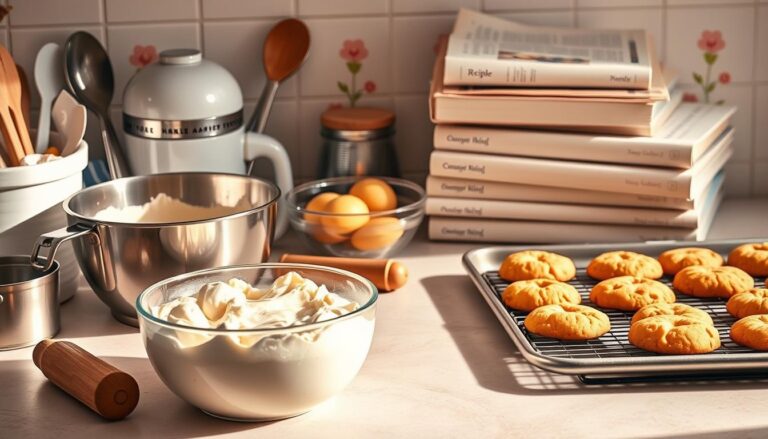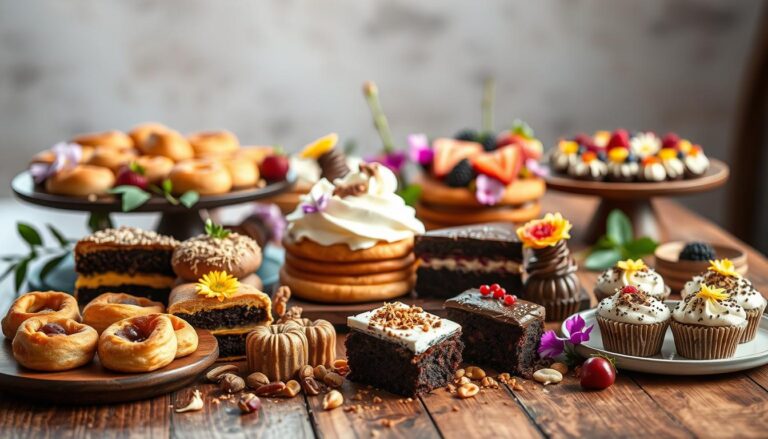Gluten-Free Baking: Tasty and Simple Recipes for Everyone
Exploring gluten-free baking is like finding a secret recipe. It changed my kitchen from limited to limitless. Now, it’s full of creativity and flavor.
Gluten-free baking is great for those with celiac disease, gluten sensitivity, or just wanting healthier treats. It shows that making tasty desserts without wheat flour is easy and fun.
Gluten-free baking isn’t about giving up. It’s about making old favorites with new ingredients. This way, you can make amazing cookies and cakes that everyone will enjoy.
Key Takeaways
- Gluten-free baking can be delicious and accessible
- Multiple flour alternatives exist for diverse recipes
- Dietary restrictions don’t limit culinary creativity
- Understanding proper techniques is key for success
- Everyone can enjoy gluten-free recipes with the right knowledge
Understanding Gluten-Free Baking Essentials
Gluten-free baking is a world of creativity and tasty treats. It’s great for those with celiac disease, gluten sensitivity, or just looking to try new things. Knowing the basics is essential for making yummy desserts.
Gluten-free baking is different from regular baking. Without gluten, you need to find new ways to make your baked goods work. Gluten-free flour blends are key to making tasty treats.
What Makes Gluten-Free Baking Unique
Wheat flour has proteins that make baked goods elastic and structured. Without gluten, you need to find other ways to get these results. Gluten-free flour blends are your new go-to for delicious desserts.
- Requires specialized ingredients
- Demands precise measuring techniques
- Needs different mixing methods
Essential Equipment for Gluten-Free Baking
Good tools are the start of gluten-free baking success. Get some important equipment to make your baking easier:
- Digital kitchen scale
- Silicone baking mats
- Xanthan gum
- Dedicated gluten-free mixing bowls
Common Gluten-Free Ingredients
Discover gluten-free flour alternatives that can change your baking. Almond flour, coconut flour, and rice flour bring unique tastes and health benefits. They’re better than traditional wheat flour.
“Gluten-free baking isn’t about limitation – it’s about exploration and creativity in the kitchen!” – Professional Baker
Learning these gluten-free baking basics will help you make treats that everyone loves. With practice and the right ingredients, you’ll soon be a gluten-free baking pro.
Best Gluten-Free Flours and Flour Blends
Finding the right gluten-free flours can be tough. But knowing your options makes baking easier. The right flour blend is key to making tasty and perfect baked goods.
Gluten-free flour blends are great for home bakers. They mix different flours to match wheat flour’s feel. This makes baking simpler, with better taste and texture.
- Almond flour is packed with nutrients and has a nutty taste
- Oat flour is smooth and mild, perfect for many recipes
- Commercial blends give consistent results in baking
Think about your diet and recipe needs when picking flour blends. Each flour type adds something special to your baking.
| Flour Type | Texture | Best Uses | Nutritional Profile |
|---|---|---|---|
| Almond Flour | Dense, moist | Cookies, cakes, pastries | High protein, low carb |
| Oat Flour | Soft, light | Breads, muffins, pancakes | High fiber, heart-healthy |
| Commercial Blend | Versatile | All-purpose baking | Balanced nutrient mix |
Try out different gluten-free flour blends to find your favorite. Mixing and matching can lead to the perfect blend for you.
Essential Tips for Successful Gluten-Free Baking
Gluten-free baking can be tricky, but with the right skills, you can make tasty treats. Learning a few key techniques will make your gluten-free baking go from hard to great.
Starting with gluten-free baking means knowing how different flours and ingredients work. Unlike regular baking, gluten-free recipes need precise measuring and special care for texture.
Precise Measuring Techniques
Getting the measurements right is key in gluten-free baking. Your measuring skills can make or break your recipe. Here are some important tips:
- Use digital kitchen scales for the most accurate measurements
- Fluff and spoon flour into measuring cups instead of scooping
- Level off dry ingredients with a straight edge
- Avoid compacting flour when measuring
Temperature and Timing Guidelines
Gluten-free baking needs careful temperature control. The batter should be a bit thicker than bread dough to avoid sinking.
- Preheat your oven completely before baking
- Use an oven thermometer to ensure accurate temperatures
- Check baked goods 5-10 minutes earlier than traditional recipes suggest
Storage and Shelf Life
Gluten-free baked goods don’t last as long as regular ones. Storing them right is key to keeping them fresh and tasty.
- Store in airtight containers at room temperature
- Refrigerate items with moisture-rich ingredients
- Freeze extras for longer preservation
- Consume within 2-3 days for the best taste and texture
With these gluten-free baking tips and measuring techniques, you’ll be on your way to making delicious treats for everyone!
Classic Gluten-Free Cookie Recipes
Craving delicious gluten-free cookies that taste just like traditional favorites? You’re in the right place! Gluten-free cookies have come a long way. They offer mouthwatering options for everyone with dietary restrictions or simply looking for healthier alternatives.
Chocolate chip cookies remain a top favorite among gluten-free bakers. The secret to perfect gluten-free chocolate chip cookies lies in selecting the right ingredients. It also involves understanding how alternative flours work.
Essential Ingredients for Gluten-Free Cookies
- Almond flour
- Coconut flour
- Gluten-free baking mix
- Xanthan gum
- High-quality chocolate chips
When making gluten-free cookies, texture is key. Almond butter can help bind ingredients together. This creates a rich and satisfying treat. Your chocolate chip cookies will be soft, chewy, and indistinguishable from traditional recipes.
| Cookie Type | Key Gluten-Free Ingredient | Baking Time |
|---|---|---|
| Chocolate Chip Cookies | Almond flour | 10-12 minutes |
| Oatmeal Cookies | Certified gluten-free oats | 12-14 minutes |
| Shortbread Cookies | Rice flour blend | 15-18 minutes |
Experiment with different gluten-free flours to find your perfect cookie recipe. Remember, gluten-free baking is an art that takes practice!
Delicious Gluten-Free Cake and Cupcake Ideas
Exploring gluten-free cakes and cupcakes is a fun journey. It’s great for those with celiac disease or anyone looking for new baking options. Gluten-free treats bring joy with their tasty flavors and soft textures.
Gluten-free baking needs special skills and ingredients. Knowing how flours and binders work is key. This knowledge helps make moist, tasty treats.
Basic Vanilla and Chocolate Gluten-Free Cakes
Learning basic gluten-free cake recipes is a great start. Here are the essential ingredients for making delicious gluten-free cakes:
- Almond flour
- Rice flour blend
- Xanthan gum
- Vanilla extract
- High-quality cocoa powder
Special Occasion Cake Recipes
Gluten-free cupcakes are perfect for any celebration. Try these unique flavor ideas:
| Cake Flavor | Unique Twist | Recommended Frosting |
|---|---|---|
| Lemon Lavender | Fresh lavender buds | Cream cheese glaze |
| Chocolate Raspberry | Fresh raspberry filling | Dark chocolate ganache |
| Carrot Spice | Toasted pecans | Maple cream cheese |
Frosting and Decoration Tips
Make your gluten-free cakes look amazing with these decorating tips:
- Use room temperature ingredients
- Pipe designs with consistent pressure
- Experiment with natural food colorings
- Add edible flowers or fresh fruit
“Baking is love made edible” – Unknown
Gluten-free cakes and cupcakes don’t have to be plain. With practice and creativity, you can make desserts that impress everyone.
Gluten-Free Bread and Pastry Making
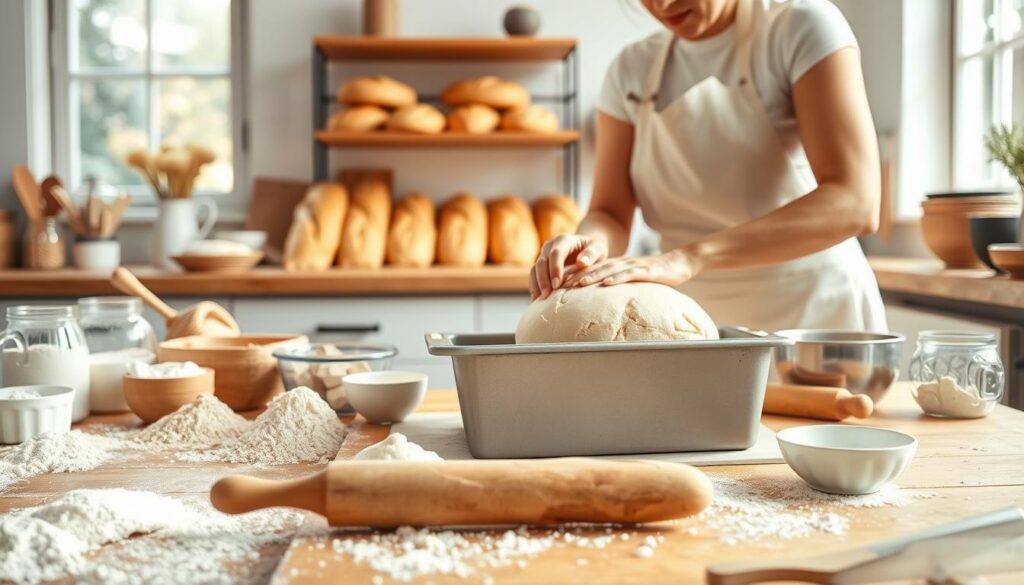
Making gluten-free bread and pastry can seem hard, but it’s doable. With the right techniques, you’ll make delicious treats that everyone will enjoy. Cassava flour is a great choice for gluten-free baking. It’s very similar to wheat flour.
Choosing the right flour blend is key to making gluten-free bread. You need to know how different flours work:
- Cassava flour gives great texture and helps things stick together
- Almond flour adds richness and keeps things moist
- Rice flour makes the bread light and crispy
- Coconut flour helps soak up extra moisture
To make flaky gluten-free pastry, pay close attention to your technique. Cold ingredients and gentle handling are essential for a perfect crust. Use a mix of gluten-free flours to keep the pastry’s shape.
“The secret to great gluten-free bread is understanding how alternative flours behave.” – Professional Baker
Getting better at gluten-free baking takes practice. Start with simple recipes and try different flour mixes. Don’t be scared to adjust the moisture levels. Gluten-free baking is an art that needs patience and creativity.
- Use xanthan gum as a binding agent
- Rest the dough before baking
- Avoid overmixing your gluten-free pastry dough
Mastering gluten-free bread and pastry takes time, but it’s worth it. Your creations will be just as good as traditional ones. Gluten-free baking can be tasty and easy.
Quick and Easy No-Bake Gluten-Free Desserts
Summer is the perfect time for no-bake gluten-free desserts. They’re sweet treats that don’t need the oven. They’re great for hot days and quick parties, perfect for those who can’t eat gluten.
No-bake gluten-free desserts are a world of tasty possibilities. You can make creamy puddings and cool frozen treats. And you don’t have to worry about gluten.
No-Bake Cookies and Bars
Making no-bake cookies and bars is easy and needs just a few ingredients. Here are some tasty choices:
- Chocolate peanut butter energy bars
- Coconut chia seed no-bake cookies
- Almond butter and honey no-bake squares
Puddings and Mousses
Gluten-free puddings and mousses are a fancy dessert. Try these yummy recipes:
- Chocolate avocado mousse
- Chia seed rice pudding with caramel sauce
- Coconut vanilla pudding
Gluten-Free Frozen Treats
Stay cool with these refreshing gluten-free frozen treats. They’re easy to make:
- Fruit and yogurt popsicles
- Banana nice cream
- Chocolate-dipped frozen fruit
No-bake gluten-free desserts show you can have fun and tasty sweets without gluten. With simple ingredients and little prep, you can make treats that everyone will love.
Troubleshooting Common Gluten-Free Baking Problems
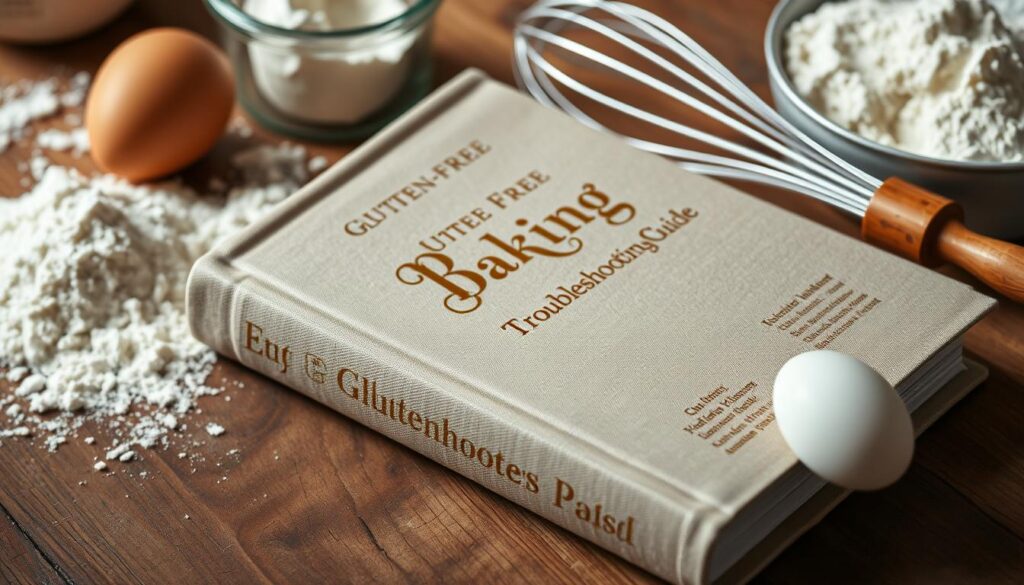
Gluten-free baking can be tricky for home bakers. Knowing common issues and how to fix them makes baking gluten-free treats easier. Many struggle with texture, moisture, and consistency without traditional wheat flour.
Common problems include getting the right texture and avoiding dry, crumbly results. Your baked goods might feel dense or fall apart, which is really disappointing.
- Moisture Control: Gluten-free flours absorb liquid differently, requiring careful measurement
- Binding Challenges: Without gluten’s natural protein structure, baked goods need alternative binding agents
- Texture Modifications: Achieving a light, fluffy consistency takes specific techniques
Fixing gluten-free baking issues takes patience and smart strategies. Xanthan gum or psyllium husk can improve texture and help ingredients stick together. Try different flour mixes to find the best one for your recipes.
Humidity and altitude can greatly affect gluten-free baking. Places at high altitudes might need more liquid or changes to leavening agents. Keep a baking journal to track your progress and successes.
Pro tip: Always measure ingredients precisely and use room temperature ingredients for the best gluten-free baking results.
Storing gluten-free baked goods right is key to keeping them fresh. Store them in airtight containers and eat them within 2-3 days for the best taste. Refrigeration can help them last longer, but watch out for moisture buildup.
Conclusion
Mastering gluten-free baking takes patience, practice, and passion. Your journey in the kitchen is just starting. Every recipe you try makes you more confident and skilled.
This guide shows that gluten-free baking is easy and rewarding. It’s perfect for those with celiac disease, food sensitivities, or just looking for new baking methods. Now, you have all you need to make tasty treats for everyone.
Gluten-free baking success comes from knowing your ingredients and trying new things. Start slow, be kind to yourself, and don’t worry about mistakes. Your baking will get better with each try.
See gluten-free baking as a chance to be creative and have fun. Your kitchen is a place for new ideas and delicious discoveries. Keep exploring, stay curious, and enjoy the gluten-free baking world.

